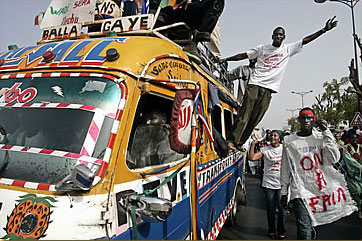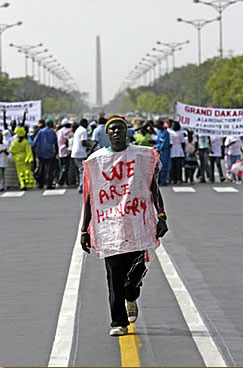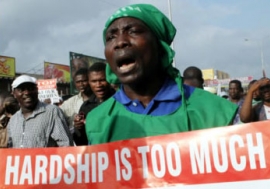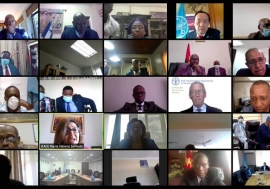Price protests expose state faults
 Hunger protest in Senegal: In many countries, demonstrators have combined demands for lower food prices with calls for greater democracy and other political reforms.
Hunger protest in Senegal: In many countries, demonstrators have combined demands for lower food prices with calls for greater democracy and other political reforms.Cheikh Diouf, from the rural community of Diakhao, walked out of a courtroom in Dakar in mid-April a free man. He was found not guilty of charges that he had “disturbed order” in Senegal’s parliament. The week before, he had managed to slip past security guards at the country’s National Assembly. As parliamentary deputies, during a break in their deliberations, walked to a restaurant in the building, Mr. Diouf brandished an empty rice sack on which he had written “The people are hungry.”
Elsewhere in Dakar — and in nearly a dozen other African countries — most protesters have not been quite as restrained. Angered by sharply rising prices of basic foodstuffs, transport, electricity and other essentials, they have poured into the streets to express their frustrations and demand that their governments act quickly to halt the spiraling cost of living. Street barricades, burning tyres, arson and sometimes deadly confrontations with riot police have been common.
Jacques Diouf, the Senegalese director-general of the UN’s Food and Agriculture Organization, warns that unless something significant is done to bring down world grain prices, “hunger riots” will likely increase around the world. Already 37 countries are threatened by food crises, he reports. If people feel they are facing starvation, “They will not let themselves die without doing something. They will react.”
But in some countries with equally severe food situations, governments have successfully averted public demonstrations by being responsive to popular concerns. Niger, an arid Sahelian country, was swept by mass protests during an earlier food crisis in 2005. The government then set up a cabinet-level ministry to coordinate action on prices. “So when prices went up this year,” Moustapha Kadi, an activist in the earlier demonstrations, told the New York Times, “the government acted quickly to remove tariffs on rice, which everyone eats. That quick action has kept people from taking to the streets.”
‘Enough is enough!’
The most immediate issue for many ordinary Africans has been the sudden increase in recent months in the prices of basic consumer goods. Climbing fuel costs have been felt widely, stoking inflation in general. The rise in prices of staple foods has been especially sharp, and has disproportionately hurt poor people, who must spend a bigger share of their meagre incomes on food than the better off. Government officials have frequently sought to blame external factors beyond their immediate control: rising world grain and oil prices, poor weather and an unfair international trading system that undermines agriculture in developing countries (see Africa struggles with soaring food prices).
 Where governments have opened dialogue with trade unions and other civil associations, protests against high food prices have been more orderly.
Where governments have opened dialogue with trade unions and other civil associations, protests against high food prices have been more orderly.However valid such explanations, the protests also reflect deep popular dissatisfaction with the way many African political systems function. Some countries swept by riots are run by autocratic or semi-authoritarian leaders who have been in power for many years and provide little room for opposition. Critics charge that the governments of these countries are inefficient, riddled with corruption and indifferent to the plight of ordinary people. If problems such as the high cost of living are to be addressed, they argue, there must be political change and greater democracy.
Even in countries such as Senegal that generally hold free elections and have had alterations in government, many people still feel they have little voice in influencing policy — unless they go out into the streets.
“Enough is enough! Prices are rising daily,” Adama Ouédraogo, a small-scale merchant, explained during violent protests in the town of Ouahigouya in Burkina Faso. “And since we have no channel for communicating with the authorities, we have chosen the streets to show our discontent.”
From Conakry to Cairo
In several countries, the price protests seemed to first erupt around the same time, in February and March, following an abrupt spike in food prices from the beginning of the year. However, here and there signs of unrest and agitation were already evident earlier.
Morocco was hit by two waves of sit-ins to protest high food prices in March and September 2007, the latter including violent clashes in Sefrou that left 50 injured; more clashes broke out in April in Rabat, in front of Morocco’s parliament.
Nouakchott and at least nine other towns in Mauritania exploded in protests in November 2007, as hungry people looted food stores and, in some instances, attacked police stations. At least one demonstrator was killed when security forces sought to disperse a crowd.
The most dramatic of the early protests were in Guinea, in January and February 2007, when anti-government demonstrations led to a crackdown that claimed nearly 200 lives and provoked a deep crisis. The grievances were both political and economic, combining dissatisfaction with the government and popular dismay over worsening living conditions. Sporadic demonstrations flared throughout that year, and in mid-February 2008 rioting over high food prices broke out again in Ratoma, just outside the capital, Conakry.
At the beginning of February, a protest in Maputo, the capital of Mozambique, over hikes in bus fares and bread prices set off a series of violent clashes in the country, reportedly leaving six people dead and more than 100 injured.
From 20–21 February, three cities in Burkina Faso (Bobo-Dioulasso, Ouahigouya and Banfora) were hit by violent riots prompted by high food prices and increased government efforts to collect taxes from small-scale merchants. Large crowds of petty traders, youths and other urban poor turned their anger against public buildings, vehicles, shops, uniformed security personnel, traffic lights, a statue of the president and other symbols of authority. A week later, on 28 February, several poor neighbourhoods erupted in Ouagadougou during a strike against high prices.
More than 1,500 kilometres away, in Cameroon’s port city of Douala, taxi drivers struck on 24 February to protest high fuel costs. That set off severe rioting in half of the country’s 10 provinces. Government officials later reported that government buildings had been burned, vandalized or looted in 31 towns, and that some 40 people were known to have been killed.
After an earlier spate of demonstrations in late 2007 in Senegal, and more recent public declarations by unions and civil society groups appealing for a halt to rising prices, two consumers’ associations called a march and sit-in on 30 March in Dakar. Their banners proclaimed “We are hungry” and “Dundu bi cherna” (life has become difficult). A riot police assault set off three hours of street clashes. More protests followed in April, including by some of the country’s trade unions.
On the last day of March, some 1,500 protesters marched in the Cocody and Yopougon districts of Abidjan, Côte d’Ivoire’s largest city, chanting “We are hungry” and “Life is too expensive, you are killing us.” Riot police moved in to disperse the crowds and one person was reportedly killed.
In Egypt, calls for a general strike spread in early April amidst growing public anger over high bread prices. Sporadic demonstrations erupted in Cairo, and riot police clashed with protesters in the northern town of Mahalla al-Kobra, the centre of the nation’s textile industry, where at least one person was killed. More protests took place in June.
On 10 April, the town of Redeyef in central Tunisia’s phosphate-mining region was rocked by clashes between police and demonstrators protesting rising living costs and high unemployment. In late April, civil society groups in Gabon also staged demonstrations against the high cost of living.
Although Africa has accounted for a notable share of the recent price protests, the continent has not been alone. Sizeable demonstrations were reported in Indonesia, Yemen and most notably Haiti, where a number of people were killed.
For freedom and bread
In most demonstrations, protesters have expressed anger not only over high food and fuel prices, but also towards the governments they hold responsible. The linking of political and economic grievances has been most evident where the same presidents and ruling parties have been in power for many years.
President Lansana Conté of Guinea has held office for a quarter-century, since he staged a military coup in 1984. Although the popular uprisings of 2007 prompted some concessions, the political reform process appears to have stalled. Protesters have cited, in particular, the government’s failure to name a commission of inquiry into police killings of demonstrators last year.
During the price protests in Cameroon, demonstrators also decried human rights abuses and plans by the ruling party to amend the 1996 constitution to make it possible for President Paul Biya, who has been in office since 1982, to run yet again for the presidency when his current term expires in 2011. The National Assembly approved the amendment on 10 April. Although opposition deputies staged a walkout to protest the move, there was little immediate public outcry. The government had simultaneously enacted several measures to bring down the prices of basic necessities, dissipating some of the anger on that issue.
Blaise Compaoré of Burkina Faso has been president since a military coup in 1987. Although opposition and civil society pressure led to a shift to multiparty elections in 1991, Mr. Compaoré’s ruling party has dominated the political scene continuously, and in 2007 widened its margin of control over parliament even further.
President Hosni Mubarak of Egypt has been in office the longest, since 1981. And while there are periodic elections, Mr. Mubarak’s party has kept any real opposition at bay. Municipal elections were held on 8 April — just two days after the anti-price demonstrations. The ruling party fielded 53,000 candidates. Although the main opposition party, the Muslim Brotherhood, initially nominated 7,754 candidates, the electoral authorities approved only 20 to actually run.
In these countries, demonstrators commonly saw the lack of political change as one factor in the widening economic gap between those with access to power and the majority of the poor. As one protester in Guinea told a reporter, that country is “super-rich,” with extensive mineral and forest reserves, but is “held hostage by predators.”
However tightly controlled some of these political systems may appear to be, the extent of the protests suggests that ordinary citizens are starting to get a sense of their potential political power and are no longer willing to remain silent. Since 2007 in Guinea, there has been an “awakening of the people’s conscience,” says Rabiatou Serah Diallo, secretary-general of the National Confederation of Workers.
Oppositionists seem to have been encouraged by the hasty economic policy concessions of some governments. They also have taken heart from television and radio reports of demonstrations in neighbouring countries. In Egypt, new technologies have facilitated protest. The calls for a general strike were circulated widely by mass cell phone messages.
Between repression and dialogue
In the face of such challenges, most governments responded with police or military force. Hundreds of protesters were arrested in Burkina Faso, and scores were quickly tried and sentenced. In addition to those killed in Cameroon, at least 1,500 people were arrested by the government’s own tally, and many more according to the opposition. In Egypt, about 100 protesters were injured, and about 250 arrested. Senegal’s demonstrations were not as large as those held elsewhere, but two consumers’ leaders who were arrested accused the police of severe brutality, including the use of electric prods.
And although Senegal is widely acknowledged to have one of Africa’s liveliest and least restricted media, riot police reacted during the demonstrations by seizing video tape from one private television station and still images from photographers, while the authorities ordered another television station to stop broadcasting film of the protests. In Cameroon and Morocco, journalists were beaten and media outlets were temporarily shut down.
But once the demonstrations appeared to have been contained, the governments in Cameroon, Senegal, Burkina Faso, Guinea, Mauritania and elsewhere responded along a different track. Besides declaring various measures aimed at bringing down consumer prices — and even at promoting greater domestic food production over the coming years — they initiated consultations with trade unions, merchants’ associations and consumers’ organizations.
Such efforts at dialogue appeared intended to elicit a measure of public understanding with explanations of what was being done to reduce prices — and what the governments are not able to do. They also projected an accommodating image, showing that government officials are not oblivious to their citizens’ concerns.
Although protests against high prices continued in Burkina Faso and Senegal since those governments opened talks with trade unions and other civil associations, the demonstrations have been more orderly and less prone to violence than the initial outbursts. In other countries where no major protests have occurred recently, including the Central African Republic and Ethiopia, authorities have acted preemptively to dampen price increases. Such initiatives indicate that taking popular grievances seriously can be an important step in meeting the challenge of high prices.














